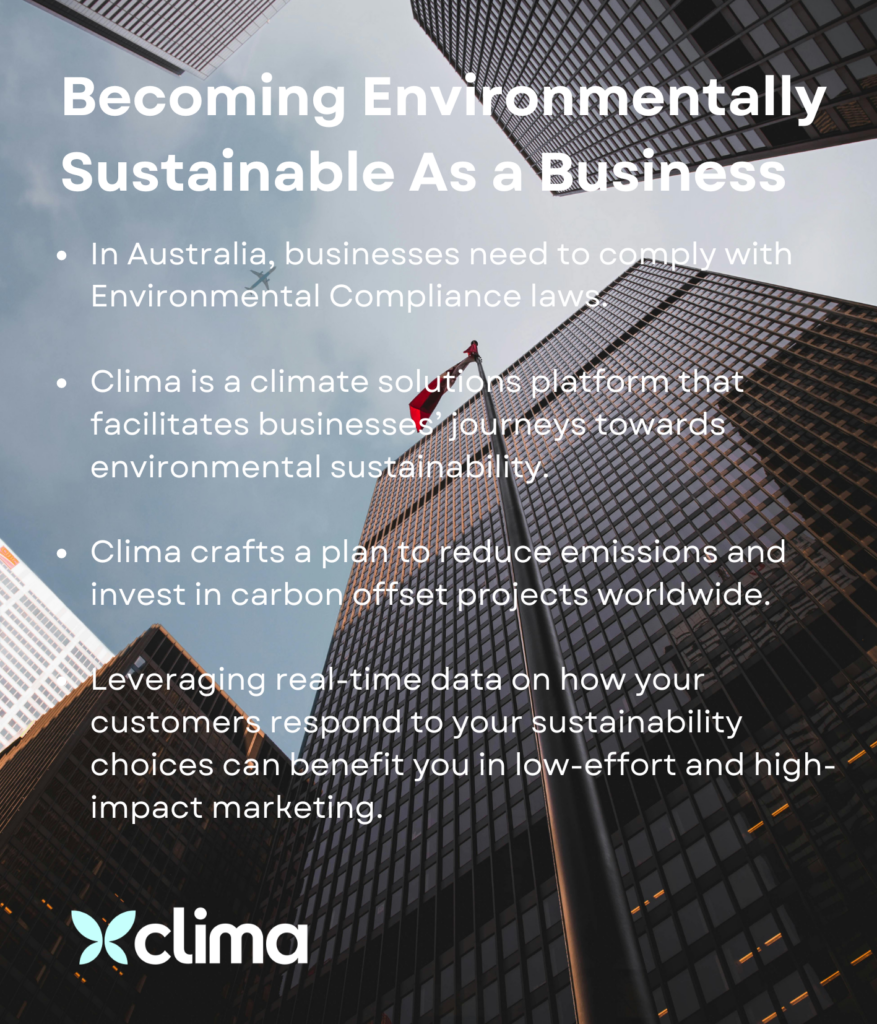Key points:
- In Australia, businesses need to comply with Environmental Compliance laws.
- Clima is a climate solutions platform that facilitates businesses’ journeys towards environmental sustainability.
- Clima crafts a plan to reduce emissions and invest in carbon offset projects worldwide.
- Leveraging real-time data on how your customers respond to your sustainability choices can benefit you in low-effort and high-impact marketing.

Table of Contents
How to Become: Environmentally Sustainable as a Business?
To become environmentally sustainable as a business, you must understand what are your company’s carbon emissions, what you can do to optimize your supply chain, is your packaging is environmentally friendly, and lastly, what changes you need to make so that your company’s moves positively towards net zero emissions. The answers to sustainability as a business will require you to dive deep into your business and what it stands for.
In Australia, there is a solid framework in place that each business must comply with if they want their business license. This framework not only serves as a way towards sustainability but also makes sure that the public remains safe and secure from harmful toxins and water pollution. The Government has strict rules and regulations that are less or more unique to each sector of the businesses.
Clima is a climate solutions platform that facilitates businesses’ journeys towards environmental sustainability. It offers various independent services, including carbon measurement, offset solutions, and client engagement tools. With Clima, businesses can effectively track and communicate their environmental efforts to engage customers and gain data insights. They are a reliable source for businesses wanting to buy carbon credits and participate in good carbon projects in Australia and internationally.
Measure Carbon Emissions
Clima helps become environmentally sustainable as a business by measuring their carbon emissions. These emissions stem from the burning of fossil fuels that most companies run on. These carbon emissions are poisonous for our environment and bringing them under control is a step towards net zero.
The first step in measuring carbon emissions is defining boundaries that outline the areas where a company has direct control or a strong influence over emissions. Boundaries usually include:
- Office Operations: Energy Usage, Remote Work
- Travel & Accommodation: Business Travel. Daily employee travel
- Waste Management: Paper Consumption, General Office Waste
- Suppliers and Partnerships: Carbon implications of business collaborations
Offset Carbon Emissions
Once the carbon emissions are measured, the next step would be to come up with strategies to decrease these emissions and offset them. Clima crafts a plan to reduce emissions, aligning with your business goals and sustainability objectives and also helps in defining the best strategies to offset any remaining emissions, ensuring a holistic approach to your carbon responsibility. Clima offers a variety of carbon offset projects for you to invest in. A description of each of these projects can be found here.
Engage With the Customers
92%* of consumers will be more likely to trust a company that supports social or environmental issues. This creates an exceptional opportunity to capitalize on customer and team member loyalty and engagement. Engaging with customers comes after you have successfully measured, optimized, and offset your carbon emissions. Leveraging real-time data on how your customers respond to your sustainability choices can benefit you in low-effort and high-impact marketing.
FAQs
Can SDGs Help in Making a Business Sustainable?
Yes, SDGs can help businesses become sustainable. Sustainable Development Goals (SDGs) are 17 goals that were adopted by the United Nations as a part of moving towards net zero emissions by 2030. Companies and businesses can thus align their environmental goals based on these SDGs. The gist of these goals is to ensure that the emissions are decreased to a minimum.
How Can Businesses Engage Their Customers For Sustainability?
Businesses can engage their customers in their sustainability journey by taking their opinions on what sort of green projects the business should invest in and what kind of sustainable packaging works best for receiving products. Real-time data on the customers and their attitude towards your sustainability choices can help you gain valuable insights into marketing strategies.
Conclusions
In conclusion, companies need to comply with Australian Environmental laws to run their businesses. Clima can help companies measure and offset their carbon emissions efficiently and optimize their emission sources. In addition to this, companies should also deploy safe and sustainable packaging that embodies their commitment to Net Zero.
Further Readings
- https://business.gov.au/environmental-management/manage-your-environmental-impact
- Australian Conservation Foundation
- https://www.ansarada.com/business-readiness/environmental/compliance
- https://www.bgateway.com/resources/environmental-responsibilities-for-businesses


